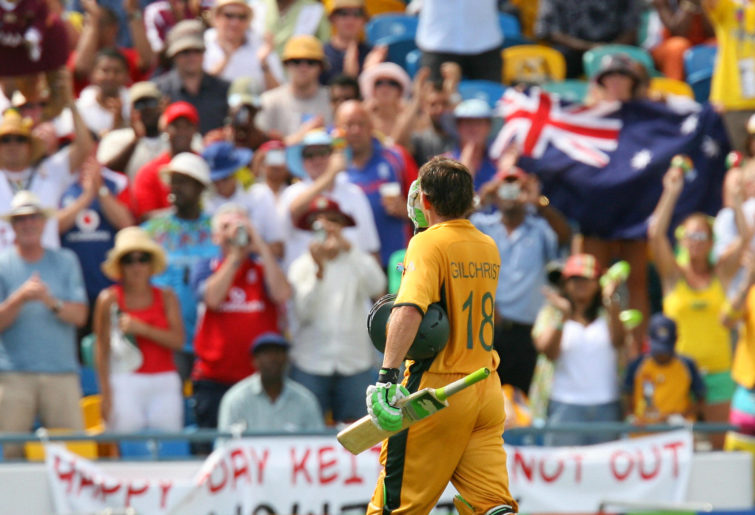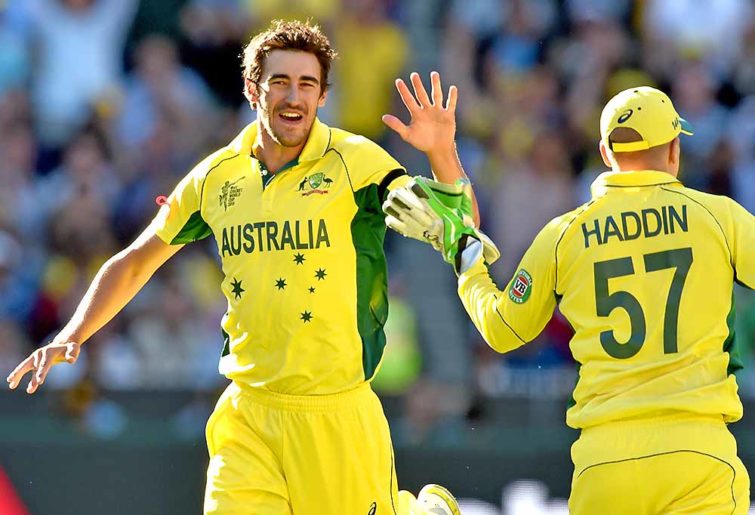World Cup chances up in the air but Smith makes Major call on T20 future, Green dumped despite huge IPL deal
Test great Steve Smith is to play for Washington Freedom in the second season of Major League Cricket as the Australian influence in the…
Kennedy Obuya is lying on the turf, squirming in agony. He rolls from one side of his body to the other, back and forth, kicking out with his right leg, almost as if in a state of convulsion.
Waves of pain are crashing over the 31-year-old Kenyan batsman like a cyclonic swell at Bell’s Beach.
“He’s in quite a bit of trouble out there at the moment,” says one commentator.
“That would have hurt” chimes in his broadcast partner.
Both remarks seem like patent understatements in light of the footage showing Obuya’s misery.
The injured cricketer is surrounded by 11 players dressed in canary yellow, among them the man who sent him into this state of physical torment, Australian quick Brett Lee.
It was a 148km/h rising delivery from Lee which smashed Obuya’s elbow. The sound it made is nauseating. To catch it you must turn up the volume and listen closely, because there are two noises which arrive in quick succession.
The first is a deep thud. That is ball on bone. The second is a higher, clicking sound. That is the Kookaburra ricocheting on to the stumps. Obuya has not just been dismissed but dismantled. Not just defeated but destroyed.
That was how it went for so many cricketers and so many cricket teams when they came up against Australia in World Cups over the past 20 years. During that time Australia won four out of the five editions of this global 50-over tournament, a reign of dominance never eclipsed in the history of cricket, across any format.
Twenty-five. That was how many consecutive wins Australia notched in World Cups across the 1999, 2003, 2007 and 2011 tournaments. They went undefeated through the entire 2003 and 2007 versions.
Australia made a habit of turning World Cup victories into massacres. Even in the finals. In the 1999 final, they humiliated Pakistan, rolling them for 132 and then sprinting to that target with a whopping 30 overs to spare.
Pakistan’s in-form batting lineup was annihilated by Australian champions Glenn McGrath and Shane Warne, who combined took 6-46 from 18 overs. Then Adam Gilchrist came out, slammed 54 from 36 balls and the charade of a contest was finished.

(Greg Wood/AFP/Getty Images)
Four years later in South Africa it was India who were the cricketing crash test dummies. Except that India weren’t behind the wheel of a Volvo, with its five-star safety rating.
Instead, they were packed into a Tata hatchback with no windshield and dodgy brakes which promptly collided with the brick wall that was the Australian cricket team.
India walked off after the first innings of the 2003 final having conceded an utterly-monstrous 2-359, which in modern terms is equivalent to 400-plus. They returned for their chase as shells of cricketers, resigned to their fate.
In the 2007 final, Australia were on track for 400 when inclement weather intervened. Gilchrist again had gone ballistic, eviscerating the Sri Lankan attack with 149 from 104 balls. Sri Lanka were set 269 from 36 overs. Against a rampant Australian attack, that was never going to be possible. Australia won in a canter.
Then four years ago a red-hot New Zealand side was trampled. The Kiwis were riding a swell of hype after a thrilling performance across that 2015 World Cup.
Their batting was deep and their bowling dangerous. That didn’t matter. As soon as that match started they were made to look like a Christchurch pub team. It was a World Cup final, after all, and World Cup finals are a playground for the Australians.
That final finished in the first over. Kiwi captain Brendon McCullum was beaten by three consecutive scorching deliveries by Australia pace dynamo Mitchell Starc. The third ball rattled not just the stumps but the entire New Zealand team. A side which had been doused in praise for playing fearless cricket suddenly retreated deep into its safe place.

(AAP Image/Joe Castro)
New Zealand hobbled their way to a meagre total of 183 which Australia mowed down at a jog. The Kiwis had been intimidated, cowed and then crushed.
It was the same tale in each of these four commanding World Cup finals performances. Australia wasn’t just too skilful. Australia wasn’t just too versatile. Australia wasn’t just too experienced. They were also too scary.
Australia had players who weren’t only great, but also brutal. Cricketers so good, so powerful or so dynamic that they took up residence in the minds of the opposition, who were distracted by worries they would be hammered or embarrassed or hurt.
The likes of Adam Gilchrist, Ricky Ponting and Matthew Hayden would do the hammering, playing innings of such relentless force that they broke the spirits of even world-class bowlers. Warne and McGrath, meanwhile, would be tasked with dishing out the embarrassment, picking apart the defences of elite batsmen with galling ease.
Then there were the torturers, the imposing quicks who would handle the hurting.
Most recently that was the two Mitchells – Starc and Johnson – who threatened to break toes and shatter helmets while operating at 150km/h in the 2015 World Cup. During the 2007 edition, express quick Shaun Tait not only reached 155kmh but also his zenith as an international cricketer, taking 23 wickets with his frightening mix of yorkers and bouncers. Yet, none of these bowlers were as scary as Lee in the 2003 tournament.
At that moment Lee was bowling consistently faster than anyone I have ever seen. In one over against England, he produced speeds of 159.7km/h, 159.9km/h and then 160.0km/h. Consider, for a moment, the current hype in the UK about new England recruit Jofra Archer operating at 150km/h. Then imagine someone bowling 10kmh quicker than that. Repeatedly. In the space of one over.
Now picture poor old Kennedy Obuya having to put his body in the path of this pace bowling maelstrom. As Obuya walked off the pitch, having finally managed to get back to his feet, he had his head buried into the shoulder of the teammate who was aiding him. Tears, agony, embarrassment, whatever it was that he was trying to conceal – it fooled no one.
Least of all the incoming Kenyan batsman who had to walk past the shattered Obuya to be the next prey in Lee’s killing field.
That man was 26-year-old Brijal Patel. Lee could have aimed for Patel’s front toe or for the peak of his helmet. Instead he took pity on the Kenyan. Lee went for the top of off stump and Patel edged to second slip with a tentative prod and, most likely, an odd sense of relief. Patel was out but, unlike Obuya, he wasn’t down and out. Lee was on a hat-trick.

Brett Lee (Photo by Hamish Blair/Getty Images)
The Australian was taking no chances with the third delivery, which he fired at the front foot of David Obuya. Having seen what happened earlier when his brother got behind a Lee delivery, Obuya shifted his foot and opened up a clear path for the ball to reach the stumps.
Lee had a hat-trick. A cruel, ruthless hat-trick. The Kenyan batsmen had been reduced from competitors to mere participants, just like so many of Australia’s World Cup opponents over the past 20 years.